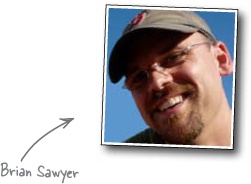How to Use This Book: Intro
Who is this book for?
If you can answer “yes” to all of these:
Do you wish you had the know-how to control your computer and make it do new things?
Do you want to learn how to program, so you can create the next big thing in software, make a small fortune, and retire to your own private island?
Do you prefer actually doing things and applying the stuff you learn over listening to someone in a lecture rattle on for hours on end?
this book is for you.
Who should probably back away from this book?
If you can answer “yes” to any of these:
Are you a seasoned programmer? Do you already know how to program?
Are you looking for a quick introduction or reference book to Python?
Would you rather have your toenails pulled out by 15 screaming monkeys than learn something new? Do you believe a programming book should cover everything and if it bores the reader to tears in the process then so much the better?
this book is not for you.
We know what you’re thinking
“How can this be a serious Programming book?”
“What’s with all the graphics?”
“Can I actually learn it this way?”
We know what your brain is thinking
Your brain craves novelty. It’s always searching, scanning, waiting for something unusual. It was built that way, and it helps you stay alive.
So what does your brain do with all the routine, ordinary, normal things you encounter? Everything it can to stop them from interfering with the brain’s real job—recording things that matter. It doesn’t bother saving the boring things; they never make it past the “this is obviously not important” filter.
How does your brain know what’s important? Suppose you’re out for a day hike and a tiger jumps in front of you, what happens inside your head and body?
Neurons fire. Emotions crank up. Chemicals surge.
And that’s how your brain knows...
This must be important! Don’t forget it!
But imagine you’re at home, or in a library. It’s a safe, warm, tiger-free zone. You’re studying. Getting ready for an exam. Or trying to learn some tough technical topic your boss thinks will take a week, ten days at the most.
Just one problem. Your brain’s trying to do you a big favor. It’s trying to make sure that this obviously non-important content doesn’t clutter up scarce resources. Resources that are better spent storing the really big things. Like tigers. Like the danger of fire. Like how you should never have posted those “party” photos on your Facebook page. And there’s no simple way to tell your brain, “Hey brain, thank you very much, but no matter how dull this book is, and how little I’m registering on the emotional Richter scale right now, I really do want you to keep this stuff around.”
Metacognition: thinking about thinking
If you really want to learn, and you want to learn more quickly and more deeply, pay attention to how you pay attention. Think about how you think. Learn how you learn.
Most of us did not take courses on metacognition or learning theory when we were growing up. We were expected to learn, but rarely taught to learn.
But we assume that if you’re holding this book, you really want to learn how to program And you probably don’t want to spend a lot of time. If you want to use what you read in this book, you need to remember what you read. And for that, you’ve got to understand it. To get the most from this book, or any book or learning experience, take responsibility for your brain. Your brain on this content.
The trick is to get your brain to see the new material you’re learning as Really Important. Crucial to your well-being. As important as a tiger. Otherwise, you’re in for a constant battle, with your brain doing its best to keep the new content from sticking.
So just how DO you get your brain to treat programming like it was a hungry tiger?
There’s the slow, tedious way, or the faster, more effective way. The slow way is about sheer repetition. You obviously know that you are able to learn and remember even the dullest of topics if you keep pounding the same thing into your brain. With enough repetition, your brain says, “This doesn’t feel important to him, but he keeps looking at the same thing over and over and over, so I suppose it must be.”
The faster way is to do anything that increases brain activity, especially different types of brain activity. The things on the previous page are a big part of the solution, and they’re all things that have been proven to help your brain work in your favor. For example, studies show that putting words within the pictures they describe (as opposed to somewhere else in the page, like a caption or in the body text) causes your brain to try to makes sense of how the words and picture relate, and this causes more neurons to fire. More neurons firing = more chances for your brain to get that this is something worth paying attention to, and possibly recording.
A conversational style helps because people tend to pay more attention when they perceive that they’re in a conversation, since they’re expected to follow along and hold up their end. The amazing thing is, your brain doesn’t necessarily care that the “conversation” is between you and a book! On the other hand, if the writing style is formal and dry, your brain perceives it the same way you experience being lectured to while sitting in a roomful of passive attendees. No need to stay awake.
But pictures and conversational style are just the beginning...
Here’s what WE did
We used pictures, because your brain is tuned for visuals, not text. As far as your brain’s concerned, a picture really is worth a thousand words. And when text and pictures work together, we embedded the text in the pictures because your brain works more effectively when the text is within the thing the text refers to, as opposed to in a caption or buried in the text somewhere.
We used redundancy, saying the same thing in different ways and with different media types, and multiple senses, to increase the chance that the content gets coded into more than one area of your brain.
We used concepts and pictures in unexpected ways because your brain is tuned for novelty, and we used pictures and ideas with at least some emotional content, because your brain is tuned to pay attention to the biochemistry of emotions. That which causes you to feel something is more likely to be remembered, even if that feeling is nothing more than a little humor, surprise, or interest.
We used a personalized, conversational style, because your brain is tuned to pay more attention when it believes you’re in a conversation than if it thinks you’re passively listening to a presentation. Your brain does this even when you’re reading.
We included more than 80 activities, because your brain is tuned to learn and remember more when you do things than when you read about things. And we made the exercises challenging-yet-do-able, because that’s what most people prefer.
We used multiple learning styles, because you might prefer step-by-step procedures, while someone else wants to understand the big picture first, and someone else just wants to see an example. But regardless of your own learning preference, everyone benefits from seeing the same content represented in multiple ways.
We include content for both sides of your brain, because the more of your brain you engage, the more likely you are to learn and remember, and the longer you can stay focused. Since working one side of the brain often means giving the other side a chance to rest, you can be more productive at learning for a longer period of time.
And we included stories and exercises that present more than one point of view, because your brain is tuned to learn more deeply when it’s forced to make evaluations and judgments.
We included challenges, with exercises, and by asking questions that don’t always have a straight answer, because your brain is tuned to learn and remember when it has to work at something. Think about it—you can’t get your body in shape just by watching people at the gym. But we did our best to make sure that when you’re working hard, it’s on the right things. That you’re not spending one extra dendrite processing a hard-to-understand example, or parsing difficult, jargon-laden, or overly terse text.
We used people. In stories, examples, pictures, etc., because, well, because you’re a person. And your brain pays more attention to people than it does to things.
Here’s what YOU can do to bend your brain into submission
So, we did our part. The rest is up to you. These tips are a starting point; listen to your brain and figure out what works for you and what doesn’t. Try new things.
Slow down. The more you understand, the less you have to memorize.
Don’t just read. Stop and think. When the book asks you a question, don’t just skip to the answer. Imagine that someone really is asking the question. The more deeply you force your brain to think, the better chance you have of learning and remembering.
Do the exercises. Write your own notes.
We put them in, but if we did them for you, that would be like having someone else do your workouts for you. And don’t just look at the exercises. Use a pencil. There’s plenty of evidence that physical activity while learning can increase the learning.
Read the “There are No Dumb Questions”
That means all of them. They’re not optional sidebars, they’re part of the core content! Don’t skip them.
Make this the last thing you read before bed. Or at least the last challenging thing.
Part of the learning (especially the transfer to long-term memory) happens after you put the book down. Your brain needs time on its own, to do more processing. If you put in something new during that processing time, some of what you just learned will be lost.
Talk about it. Out loud.
Speaking activates a different part of the brain. If you’re trying to understand something, or increase your chance of remembering it later, say it out loud. Better still, try to explain it out loud to someone else. You’ll learn more quickly, and you might uncover ideas you hadn’t known were there when you were reading about it.
Drink water. Lots of it.
Your brain works best in a nice bath of fluid. Dehydration (which can happen before you ever feel thirsty) decreases cognitive function.
Listen to your brain.
Pay attention to whether your brain is getting overloaded. If you find yourself starting to skim the surface or forget what you just read, it’s time for a break. Once you go past a certain point, you won’t learn faster by trying to shove more in, and you might even hurt the process.
Feel something.
Your brain needs to know that this matters. Get involved with the stories. Make up your own captions for the photos. Groaning over a bad joke is still better than feeling nothing at all.
Write a lot of code!
There’s only one way to learn to program: writing a lot of code. And that’s what you’re going to do throughout this book. Coding is a skill, and the only way to get good at it is to practice. We’re going to give you a lot of practice: every chapter has exercises that pose a problem for you to solve. Don’t just skip over them—a lot of the learning happens when you solve the exercises. We included a solution to each exercise—don’t be afraid to peek at the solution if you get stuck! (It’s easy to get snagged on something small.) But try to solve the problem before you look at the solution. And definitely get it working before you move on to the next part of the book.
Read Me
This is a learning experience, not a reference book. We deliberately stripped out everything that might get in the way of learning whatever it is we’re working on at that point in the book. And the first time through, you need to begin at the beginning, because the book makes assumptions about what you’ve already seen and learned.
This is not Head First Python.
We use release 3 of the Python programming language throughout this book, but this fact alone does not make this book Head First Python. We chose Python because it’s a great programming language to start with and it’s also a great programming language to grow with. In fact, Python might be the only programming language you’ll ever need to learn and use (although your employer might think otherwise). Of course, you have to start with something, and we can think of no better programming language to use than Python when first learning how to program. That said, this book isn’t designed to teach you Python; it’s designed to teach you programming, so most of the things we show you are designed to hightlight the programming concept, not the Python feature.
You need to install Python 3 on your computer.
To run the programs in this book, you need to download and install Python 3 on your computer. This isn’t as hard as it sounds. Pop on over to the Python download site and select the option that fits best with the computer you are using. Just be sure to select release 3 of Python, not release 2: http://www.python.org/download.
We begin by teaching some basic programming concepts, then we start putting programming to work for you right away.
We cover the fundamentals of programming in Chapter 1. That way, by the time you make it all the way to Chapter 2, you are creating programs that actually do something real, useful, and—gulp!—fun. We are guessing you’ll be amazed by how much you can do with less than a dozen lines of code in Chapter 2. The rest of the book then builds on your programming skills turning you from programming newbie to coding ninja master in no time.
The activities are NOT optional.
The exercises and activities are not add-ons; they’re part of the core content of the book. Some of them are to help with memory, some are for understanding, and some will help you apply what you’ve learned. Don’t skip the exercises.
The redundancy is intentional and important.
One distinct difference in a Head First book is that we want you to really get it. And we want you to finish the book remembering what you’ve learned. Most reference books don’t have retention and recall as a goal, but this book is about learning, so you’ll see some of the same concepts come up more than once.
The examples are as lean as possible.
Our readers tell us that it’s frustrating to wade through 200 lines of an example looking for the two lines they need to understand. Most examples in this book are shown within the smallest possible context, so that the part you’re trying to learn is clear and simple. Don’t expect all of the examples to be robust, or even complete—they are written specifically for learning, and aren’t always fully-functional.
We’ve placed a lot of the code examples on the Web so you can copy and paste them as needed. You’ll find them at two locations:
http://www.headfirstlabs.com/books/hfprog/ and http://programming.itcarlow.ie
The Brain Power exercises don’t have answers.
For some of them, there is no right answer, and for others, part of the learning experience of the Brain Power activities is for you to decide if and when your answers are right. In some of the Brain Power exercises, you will find hints to point you in the right direction.
The technical review team
Technical Reviewers:
Doug Hellmann is a Senior Software Engineer at Racemi and former Editor in Chief for Python Magazine. He has been programming in Python since version 1.4 and prior to Python worked mostly with C on a variety of Unix and non-Unix platforms. He has worked on projects ranging from mapping to medical news publishing, with a little banking thrown in for good measure. Doug spends his spare time working on several open source projects; reading science fiction, history, and biographies; and writing the Python Module of the Week blog series.
Jeremy Jones is the coauthor of Python for Unix and Linux System Administration and has been actively using Python since 2001. He has been a developer, system administrator, quality assurance engineer, and tech support analyst. They all have their rewards and challenges, but his most challenging and rewarding job has been husband and father.
Ted Leung has been programming in Python since 2002 and is currently a Principal Software Engineer at Sun Microsystems. He has a Bachelor of Science degree in Mathematics from the Massachusetts Institute of Technology and a Master’s of Science degree in computer science from Brown University. Ted’s weblog is available at http://www.sauria.com/blog
Bill Mietelski has been an Information Technology geek for over 20 years. He’s currently a Software Engineer at a leading national academic medical center in the Chicagoland area, working on statistical research studies. When he’s not at the office or tied to a computer, you’ll find him at a golf course chasing a little white ball.
Acknowledgments
Our editor:
Brian Sawyer was Head First Programming’s editor. When not editing books, Brian likes to run marathons “for fun.” It transpires that this was the perfect training for working on the marathon that producing this book turned into. At times, Brian worked us very hard, and, consequently, we have a much better book.
The O’Reilly team:
Brett McLaughlin, the Series Editor, kept an eye on what we were up to and on more than once occasion came to our rescue we when we found ourselves in trouble. Karen Shaner provided administrative support and very capably coordinated our techical review process.
Friends and colleagues:
David and Paul are especially grateful to Lou Barr for first thinking that the two of them might like to work together on this book, suggesting they do, and then working hard to get the idea approved at O’Reilly. Thanks, Lou!
David: My thanks to Kathy Sierra and Bert Bates for this extraordinary series of books. And to Andy Parker and Joe Broughton and Carl Jacques and Simon Jones and the many other friends who have heard so little from me whilst I was busy scribbling away.
Paul: My thanks to Nigel Whyte, Head of Department, Computing and Networking at The Institute of Technology, Carlow for supporting my involvement in yet another writing project. Also at work, Dr. Christophe Meudec reviewed the early chapters and offered some very welcome words of encouragement, together with suggestions as how to make things just that little bit better. Joseph Kehoe also reviewed the early material and liked what he saw.
Family:
David: I owe a very particular thank you to my wife, the author of Head First Statistics, Dawn Griffiths. For her wit, humor, patience, and ability to turn vague ideas into real chapters.
Paul: Thanks are due to my father, Jim Barry, who reviewed the early, draft material and (once again) pointed out where my writing could be improved and clarified. Regretfully, my home life suffered as working on this book grew to consume all of my free time. Deirdre, Joseph, Aaron, and Aideen had to bear the grunts and groans, huffs and puffs, and more than a few roars as the pressure reached boiling point on more than one occasion. I sometimes wonder how they put up with me, but somehow they do, and I’m very grateful for their ongoing love and support.
The without-whom list:
Our technical review team did an excellent job of keeping us straight and making sure what we covered was spot on.
Finally, we both owe a huge debt of gratitude to David’s wife, Dawn, who not only looks after David, but also got involved in the production of this book at a time when things looked like we’d never finish. Without Dawn’s help, this book would never have been done on time. Dawn is the Head First Programming guardian angel.
Safari® Books Online
When you see a Safari® icon on the cover of your favorite technology book that means the book is available online through the O’Reilly Network Safari Bookshelf.
Safari offers a solution that’s better than e-books. It’s a virtual library that lets you easily search thousands of top tech books, cut and paste code samples, download chapters, and find quick answers when you need the most accurate, current information. Try it for free at http://safari.oreilly.com.











